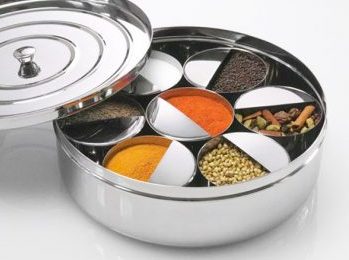Mama’s Punjabi Recipes: Loonki or Namakdani (The Spice Box)
Saved under Community, Current Stories, Recipe Corner
Tags: Baytown, Clear Lake, Cypress, Desi news, Greater Houston, Houston, Houston Desi news, India, Indian American community, Indian News, Indians in America, Indo-American News, Katy, NRI, pearland, south asia, South India, Sugar Land, Texas, USA
Learning to make food dishes well requires a basic understanding of some of the fundamentals involved in the cooking process. Each type of cuisine has its own ingredients and it’s important to known how these will play with each other to create the desired flavor of the dish. While most cuisines of the world are focused mostly on meat or fish based dishes, Indian cuisine has perfected the art of using a unique blend of spices and the building blocks – onions, tomatoes, garlic, cream – in creating exquisite vegetarian and non-vegetarian food to a degree that other cuisines find hard to imitate.
And it all starts from learning the uses of spices which are the key to learning Indian cooking. You have to learn to distinguish their smells, how they will effect the vegetables (or meats) and what desired taste you want to create for the dish being prepared. Not all spices go well with all vegetables and you should understand what the flavor is that you want to create.
I learnt to cook as a young 9 year-old girl in my ancestral home in Lyallpur from my mother whom everyone called biji. I would sit next to her in the large rasoyi (kitchen) and she would tell me, “here, take these padde (dough balls) and make some rotis (bread).” I would complain that they would come out all crooked and not round, and my father, whom we called bauji, would call out that it didn’t matter, he’d eat all the crooked ones I made!
I didn’t really learn to make any dishes until I was married and we had moved to Delhi in 1947 when I was 19. I would ask biji, who was a good cook, to teach me a few dishes every time I went to visit her in Daryagunj in Old Delhi. I first learnt to make the batter to make pakoras (fried fritters) with my sister-in-law Savitri who was also my age. I refined my skills as I grew older, had my own family and we moved to London.
The basic ingredients for all Indian food lie in a box of spices which is called loonki in Punjabi or namakdani in Hindi. The old style loonki was a rectangular box made of wood, with six to eight compartments and a lid that would slid open. Each compartment had the basic spices – two for namak (salt) as it is used a lot; and one each for powdered lal mirch (red pepper), haldi (turmeric), dhania (coriander), garam masala and jeera (cumin). The extra compartment would hold some loung (cloves), kalli illachi (balck cardamom) and daal chinni (sticks of cinnamon) for the few times they would be needed, like in making basmati chawal (rice). Some people add saunth (ginger powder) in the last compartment instead.
Of course, there are many other spices that go into making Punjabi Indian dishes, like adrak (ginger) which is best if used fresh and not as a powder; lassan (garlic) also best is used fresh. Other spices like jaiphal (nutmeg); sarson til (mustard seeds) and kali mirch til (black pepper seeds – the powder is not often used in Indian food) are usually kept in bottles on the shelf, but are not used daily.
In the US, it’s surprising to me that many younger Indian men and women have no concept of the loonki and the way the spices are used. Most of them – especially the second generation – may have seen their mothers using the modern day version, a stainless steel round box with compartments, or a cheaper plastic model but few have one of their own, preferring to use bottles in a spice rack. There is certainly a sense of tradition and closeness to the food you are cooking when using a loonki, which doesn’t come from spices in a bottle!

Shakuntla Malhotra is a skilled cook of Punjabi dishes made in the old-fashioned style that she learnt as a young woman in her ancestral home in Lyallpur (since renamed Faisalabad), India before it became part of Pakistan after the Partition in 1947. People have often admired her cooking for its simplicity and taste that comes with each mouthful. Even in her mid-eighties, she continues to cook daily and agreed to share some of her delectable Punjabi recipes

